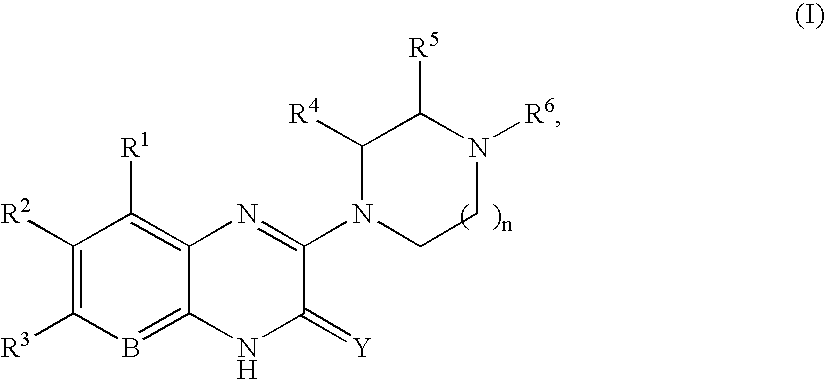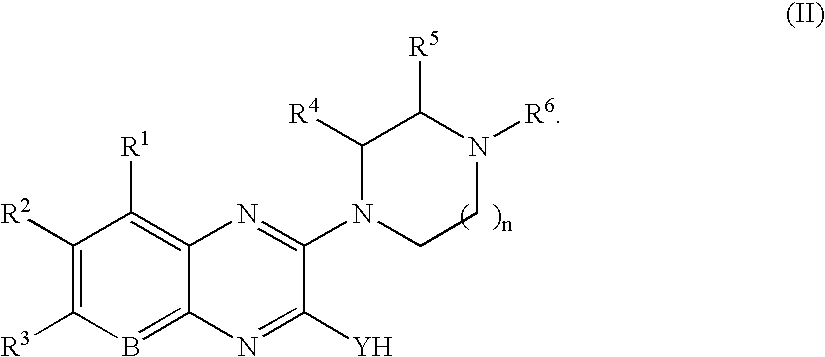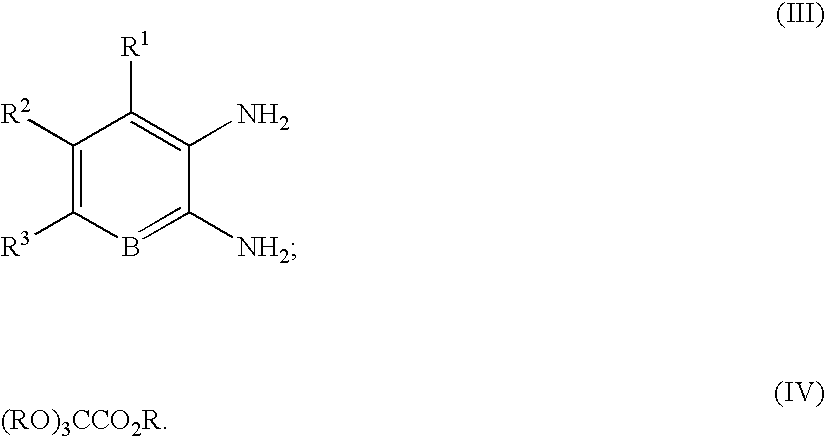Quinoxaline compounds
a technology of quinoxaline and compounds, applied in the field of new, pharmaceutically active, fused heterocyclic compounds, can solve the problems of significantly less potency of -methylhistamine than histamine, and achieve the effects of inhibiting leukocyte recruitment, inhibiting leukocyte recruitment, and inhibiting leukocyte recruitmen
- Summary
- Abstract
- Description
- Claims
- Application Information
AI Technical Summary
Benefits of technology
Problems solved by technology
Method used
Image
Examples
example 1
8-Methyl-3-(4-methyl-piperazin-1-yl)-1H-quinoxalin-2-one.
Method A
General Procedure 1:
A. 3-Methoxy-8-methyl-1H-quinoxalin-2-one. A mixture of 2,3-diaminotoluene (2.00 g, 16.4 mmol), trimethoxy-acetic acid methyl ester (5.37 g, 37.7 mmol), and ytterbium triflate (1.0 g, 1.64 mmol) in toluene (50 mL) was heated at 100° C. for 14 h in a sealed tube. The reaction mixture was cooled, and the precipitate was collected by vacuum filtration. After washing with toluene (2×50 mL), the precipitate was dried in vacuo to afford 1.5 g (48%) of 3-methoxy-8-methyl-1H-quinoxalin-2-one, which was used without further purification. MS (electrospray): mass calculated for C10H10N2O2, 190.2; m / z found, 191.1 [M+H]+. 1H NMR (400 MHz, CDCl3): 11.34 (br s, 1H), 7.25 (d, J=7.8 Hz, 1H), 7.13-7.10 (m, 2H), 4.14 (s, 3H), 2.59 (s, 3H).
General Procedure 2:
B. 8-Methyl-3-(4-methyl-piperazin-1-yl)-1H-quinoxalin-2-one. To a sealed tube containing 3-methoxy-8-methyl-1H-quinoxalin-2-one (50 mg, 0.26 mmol) in ...
example 2
8-Methyl-3-piperazin-1-yl-1H-quinoxalin-2-one.
The reaction was carried out as described in General Procedure 2 using 3-methoxy-8-methyl-1H-quinoxalin-2-one (50 mg, 0.26 mmol) and piperazine (113 mg, 1.32 mmol). Purification afforded 23 mg (46%) of the title compound. MS (electrospray): mass calculated for C13H16N4O, 244.3; m / z found, 245.2 [M+H]+. 1H NMR (400 MHz, CDCl3): 9.5 (br s, 1H), 7.39 (d, J=8.3 Hz, 1H), 7.15-7.12 (m, 1H), 7.05 (d, J=7.1 Hz, 1H), 3.98-3.95 (m, 4H), 3.08-3.02 (m, 4H), 2.42 (s, 3H).
example 3
8-Nitro-3-piperazin-1-yl-1H-quinoxalin-2-one.
A. 3-Methoxy-8-nitro-1H-quinoxalin-2-one. The reaction was carried out as described in General Procedure 1 using 3-nitro-1,2-phenylenediamine (2.0 g, 13.1 mmol). After cooling to room temperature, the reaction mixture was concentrated in vacuo and used without further purification. MS (electrospray): mass calculated for C9H7N3O4, 221.0; m / z found, 222.1 [M+H]+. 1H NMR (400 MHz, CD3OD): 8.31 (d, J=8.0 Hz, 1H), 7.98 (d, J=8.0 Hz, 1H), 7.43 (t, J=8.0 Hz, 1H), 4.11 (s, 3H).
B. 8-Nitro-3-piperazin-1-yl-1H-quinoxalin-2-one. The reaction was carried out as described in General Procedure 2 with 3-methoxy-8-nitro-1H-quinoxalin-2-one (100 mg, 0.45 mmol) and piperazine (155 mg, 1.80 mmol). Purification by silica gel chromatography (0-5% MeOH / DCM) afforded 21 mg (17%) of the title compound. 1H NMR (400 MHz, CDCl3): 8.12 (d, J=8.0 Hz, 1H), 7.77 (d, J=8.0 Hz, 1H), 7.24 (t, J=8.0 Hz, 1H), 4.10-4.08 (m, 4H), 3.03-3.00 (m, 4H).
PUM
| Property | Measurement | Unit |
|---|---|---|
| composition | aaaaa | aaaaa |
| temperature | aaaaa | aaaaa |
| swelling | aaaaa | aaaaa |
Abstract
Description
Claims
Application Information
 Login to View More
Login to View More - R&D
- Intellectual Property
- Life Sciences
- Materials
- Tech Scout
- Unparalleled Data Quality
- Higher Quality Content
- 60% Fewer Hallucinations
Browse by: Latest US Patents, China's latest patents, Technical Efficacy Thesaurus, Application Domain, Technology Topic, Popular Technical Reports.
© 2025 PatSnap. All rights reserved.Legal|Privacy policy|Modern Slavery Act Transparency Statement|Sitemap|About US| Contact US: help@patsnap.com



